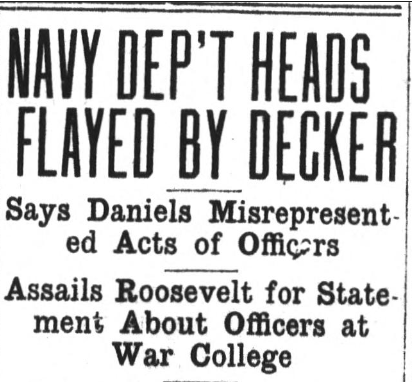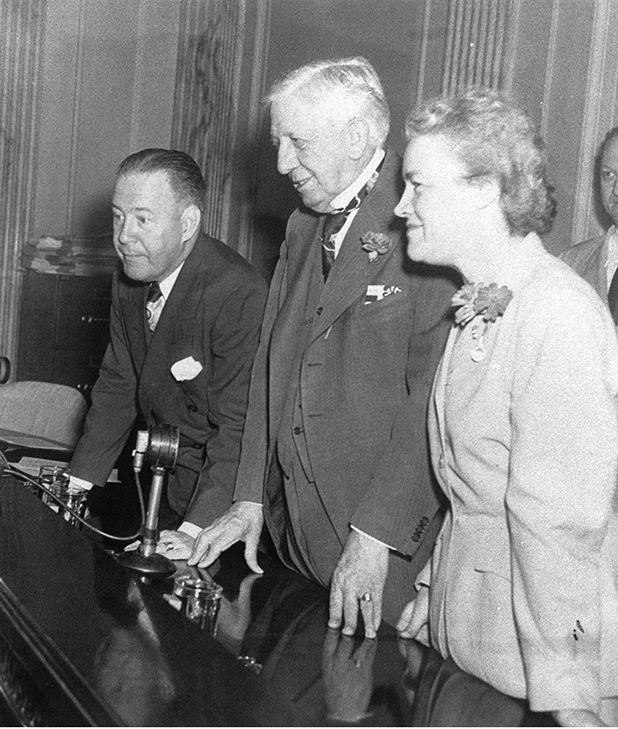See also: The Lavender Scare in North Carolina on ANCHOR

The Lavender Scare was a moral panic that spread throughout the United States after World War II. The Lavender Scare was a subset of the national Red Scare, but its subject was gay and lesbian Americans rather than Communists. The Lavender Scare led to mass firings and discrimination against gay and lesbian Americans posing as a matter of “national security.” The Lavender Scare is also closely connected to North Carolina. Some of the Scare’s key figures, like Josephus Daniels, Clyde Hoey, and James Webb, were prominent North Carolinians.
The start of the national Lavender Scare likely originated with the Newport Scandal. Civilian witness reports from Newport, Rhode Island, alleged that a network of gay men, primarily from the Navy, were using the Army and Navy YMCA to pursue same-sex relationships. In March 1919, Franklin D. Roosevelt, then Assistant Secretary of the Navy, and Josephus Daniels, Secretary of the Navy, investigated the reports. Roosevelt, Daniels, and Navy officials tasked specific soldiers with observing and reporting evidence of gay men in the military through entrapments and sting operations. From April until October 1919, about twenty Navy sailors were imprisoned and held in unsanitary conditions with little food or water and without due process. When finally tried, they were dishonorably discharged. The surveillance methods, treatment of soldiers, and findings of the Newport Scandal worried many US citizens. Senators sitting on the US Senate Committee for Naval Affairs who reviewed Roosevelt and Daniel’s findings stated that the methods used in the Newport investigations deviated from the “American standard of morality.” They also recommended that Roosevelt and Daniels never hold public office again after their involvement in the Newport Scandal.
During his presidency from 1933 to 1945, Roosevelt also implemented many policies that impacted the participation of gay people in the military. In 1940, Roosevelt added psychological screenings as a requirement for individuals applying for military service. The implementation of the screenings was an attempt to identify people within the military who were not heterosexual, or attracted to a different sex. Gay and lesbian people were excluded from serving in the armed forces when they were ruled “unfit” for duty by the standards of the screenings. In 1943, FDR banned gay people from participating in all military branches, and in 1945, servicemembers discharged for being gay could no longer receive pay benefits.
In addition to discrimination in the military, Harry S. Truman’s presidency added more restrictions for gay and lesbian government employees. In 1947, Truman ordered all federal employees to be vetted for their positions in government. This action was to determine two factors: their loyalty to the United States and their sexuality.
At the same time, Congress created a congressional committee for investigations concerning gay people. It was established by Senator Clyde R. Hoey (D-NC), a former North Carolina Governor. In addition to Senator Hoey, the committee was made up of Democratic senators James Eastland, John McClellan, and Herbert O'Conor and Republican Senators Karl Mundt, Andrew Schoeppel, and Margaret Chase Smith. Its purpose was to investigate gay people within the US government. On December 15, 1950, the Hoey Report outlined their investigation into several US government institutions. It included federal government agencies, courts, and law enforcement offices in Washington, D.C. Senator Hoey’s committee stated that gay and lesbian Americans “are not proper persons to be employed in Government for two reasons; first, they are generally unsuitable, and second, they constitute security risks in positions of public trust.” Little to no evidence was found to support this claim.
James Webb’s compound role in the Lavender Scare also began around this time. In 1949, Truman asked Webb to serve as Under Secretary of State in the U.S. Department of State. He held this role until 1952. Before his time at the State Department, investigations and firings were already taking place–as many as ninety-one gay and lesbian employees were fired between 1947 and 1950. In 1950, Webb worked with Truman and the Hoey Committee to create and submit “material related to the security program.” Webb, however, also worked to prevent investigations from the Hoey Committee from escalating within the State Department. Webb later served as NASA's Administrator from 1961 to 1968. While sexuality-related firings did occur under his tenure, “it is unlikely that the issue [of sexuality-related firings] was ever presented to Webb in his role as NASA Administrator.”

President Eisenhower continued Truman’s campaign when he signed Executive Order 10450 on April 29, 1953. It banned, among others, all gay people from working for the federal government or any of its private contractors. The Executive Order labeled gay and lesbian people an “immoral” security risk. The Executive Order also claimed that they were more likely to be blackmailed by foreign intelligence based on their sexual orientation. The now-lawful investigation of all federal employees was based on the findings of the 1950 Hoey Report. Between 1947 and 1961, more people were fired for their sexual orientation than their associations with the Communist Party. According to the White House, estimates of 5,000 to 10,000 people were fired or resigned from employment in the federal government as a result of the Lavender Scare. People who were interrogated and fired as part of the Lavender Scare also often died by suicide.
There were numerous opponents to the policies of the Lavender Scare. Astronomer Frank Kameny, along with other gay and lesbian activists, formed a notable resistance to the Lavender Scare in the 1950s. Kameny wrote letters to members of Congress, the Attorney General, the President, the State Department, and other branches of the federal government. These letters are now known as the Kameny Papers. In these letters, Kameny spoke of the mistreatment of gay people whose Constitutional rights, like due process, were being violated because of their sexual orientation.
Opposition also expanded through legal challenges to the Lavender Scare. Notable suits centered around policies of the Lavender Scare included: Scott v. Macy (1965), Clifford Norton v. John Macy, et al. (1969), Society for Individual Rights, Inc. v. Hampton (1973), Hickerson v US Civil Service Commission (1975), Singer v. The United States Civil Service Commission (decided 1976), Matlovich v. Secretary of the Air Force (decided 1978), and National Security Agency v Jamie Shoemaker (1980).
The social standing of LGBTQIA+ Americans was again tarnished in the late 1980s by the Human Immunovirus (HIV) and Acquired Immunodeficiency Syndrome (AIDS) epidemic. The HIV/AIDS epidemic killed about 100,000 people between 1981 and 1990. A significant portion of those killed were gay men. The epidemic stoked pre-existing fears over the physical and mental health of gay people and helped renew negative public opinion against them. This revived wave of negative public opinion was present in North Carolina in places like Charlotte.
The policies of the Lavender Scare remained within the federal government well into the 1990s. In October 1993, President Bill Clinton signed a new policy into law called “Don’t Ask, Don’t Tell” (DADT). DADT maintained that openly gay and lesbian people would not be allowed to serve in the military. However, it also promoted a new directive of “Don’t Ask, Don’t Tell, Don’t Pursue, and Don’t Harass.” This policy relaxed Lavender Scare-era investigations and culture. However, the "Don't Tell" portion of DADT specified that service members should not disclose their sexual orientation. If they were to speak about their same-sex relationships, they would be subject to discharge. From DADT’s signing in 1993 until its repeal in 2011, over 13,000 officers were discharged from the military because they did not hide their identity. After DADT’s repeal, many service members on military bases, including Fort Liberty (then Fort Bragg) in Fayetteville, North Carolina, throughout the United States celebrated.
The influence of the Lavender Scare was further diminished when President Clinton signed Executive Order 12968 in 1995. The Order expanded on President Eisenhower's Executive Order 10450 and declared that sexual orientation should not be a determinant for security clearance. The Order stated, "The United States Government does not discriminate on the basis of race, color, religion, sex, national origin, disability, or sexual orientation in granting access to classified information."
Echoes of the Lavender Scare can still be felt across our society today. This ongoing debate spans all government levels, from local city councils to the federal government. As of May 2023, over 520 different pieces of legislation (along with seventy new laws) have been issued across the United States, including North Carolina. Resources like information and medical care of LGBTQIA+ Americans are the primary targets of the new legislation.